MARIANI’S
Virtual
Gourmet
December
9, 2018
NEWSLETTER
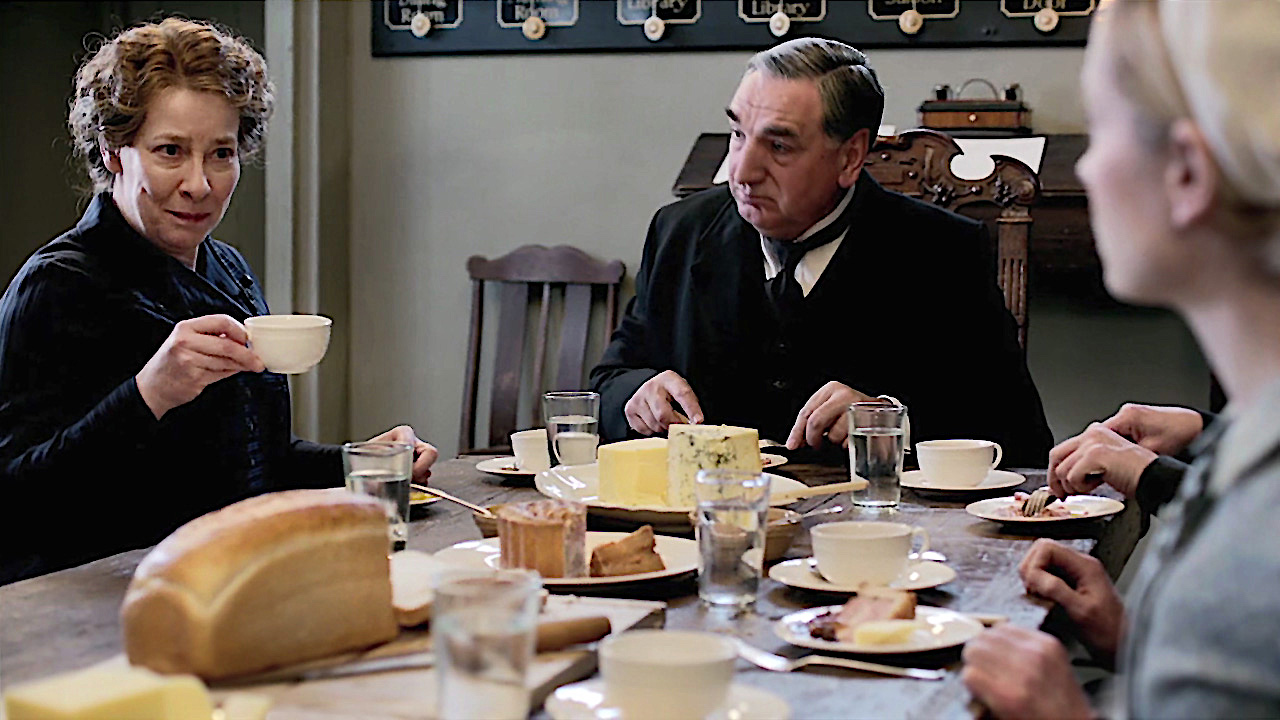
Phyllis
Logan and Jim Carter in "Downton Abbey"
IN THIS ISSUE
ST. BARTS BOUNDS BACK
By John Mariani
NEW YORK CORNER
BOCAPHE
By John Mariani
NOTES FROM THE WINE CELLAR
VILLADORIA AIMS HIGH FOR BAROLO
By John Mariani
❖❖❖
ST. BARTS BOUNDS BACK
By John Mariani
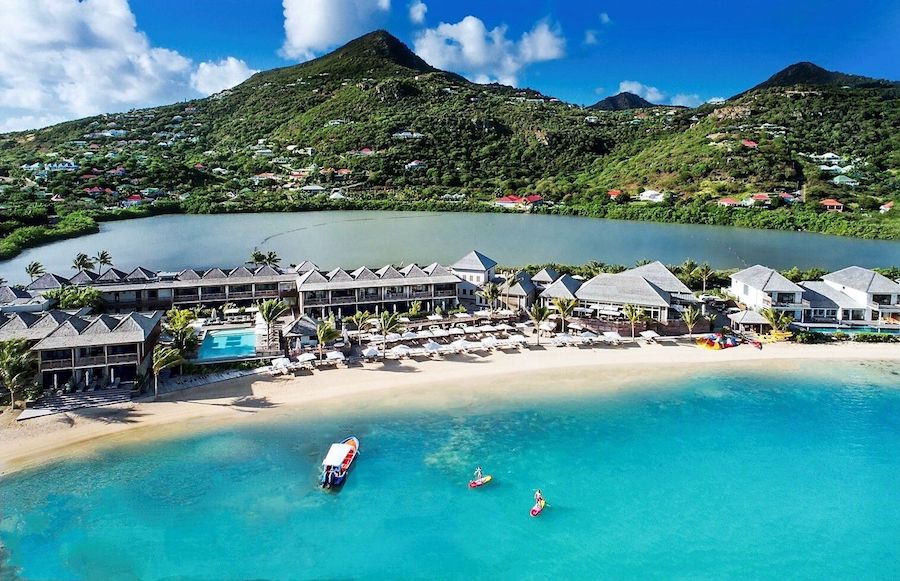
Le Barthélemy Hotel & Spa
Although
God told Noah after the flood that He’d never
destroy Earth by water again, the people of
Saint Barthélemy must have had their doubts last
year when Hurricane Irma obliterated the
French-Caribbean island. With losses exceeding
$1.4 billion, St. Barts lost much of its
infrastructure, water, electricity and phone
service. Roads looked bombed out. Plants and
trees washed away. Houses and hotels destroyed.
All tourism—the island’s only industry—ceased.
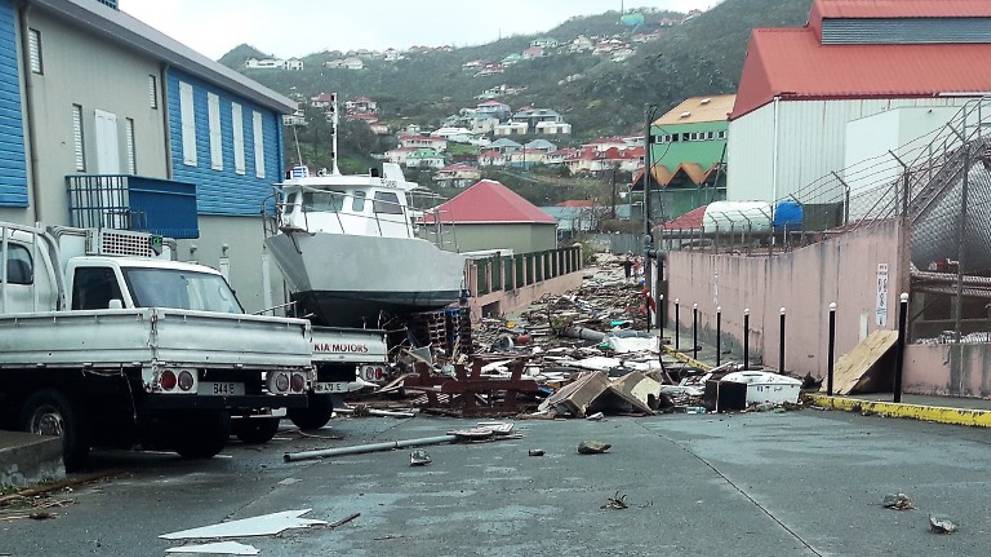 Yet, flying
in from St. Maarten over the choppy Caribbean last
month, I saw St. Barts today looking tranquil, its
red roofs restored, the island turning green
again. If
not back to paradisal levels, St. Barts is alive
and well. All
it took was tons of money—in this case euros—which
is something St. Barts has plenty of, despite
levying no income tax. Refusing to wait for the
grinding bureaucracy of the Mother Country to send
aid, St. Barts’s citizens, municipal authorities
and investment companies got to work. Today 70% of
the island’s phone and electrical lines are
underground; within months they expect that figure
will be 100%.
Yet, flying
in from St. Maarten over the choppy Caribbean last
month, I saw St. Barts today looking tranquil, its
red roofs restored, the island turning green
again. If
not back to paradisal levels, St. Barts is alive
and well. All
it took was tons of money—in this case euros—which
is something St. Barts has plenty of, despite
levying no income tax. Refusing to wait for the
grinding bureaucracy of the Mother Country to send
aid, St. Barts’s citizens, municipal authorities
and investment companies got to work. Today 70% of
the island’s phone and electrical lines are
underground; within months they expect that figure
will be 100%.
“Very little money came from
France for the reconstruction,” Nils Dufau, vice
president in charge of tourism, told me over lunch
at Nikki Beach, “but France did waive the annual
payment of €2.9 million we pay for services.”
True, many of the main roads
are still damaged and impassable, so déviations over
narrow,
rutted side roads are numerous, which makes
driving for a visitor as hair-raising as in an
Anglo country where they drive on the left side of
the road. When you rent a car, they heartily
advise you to get 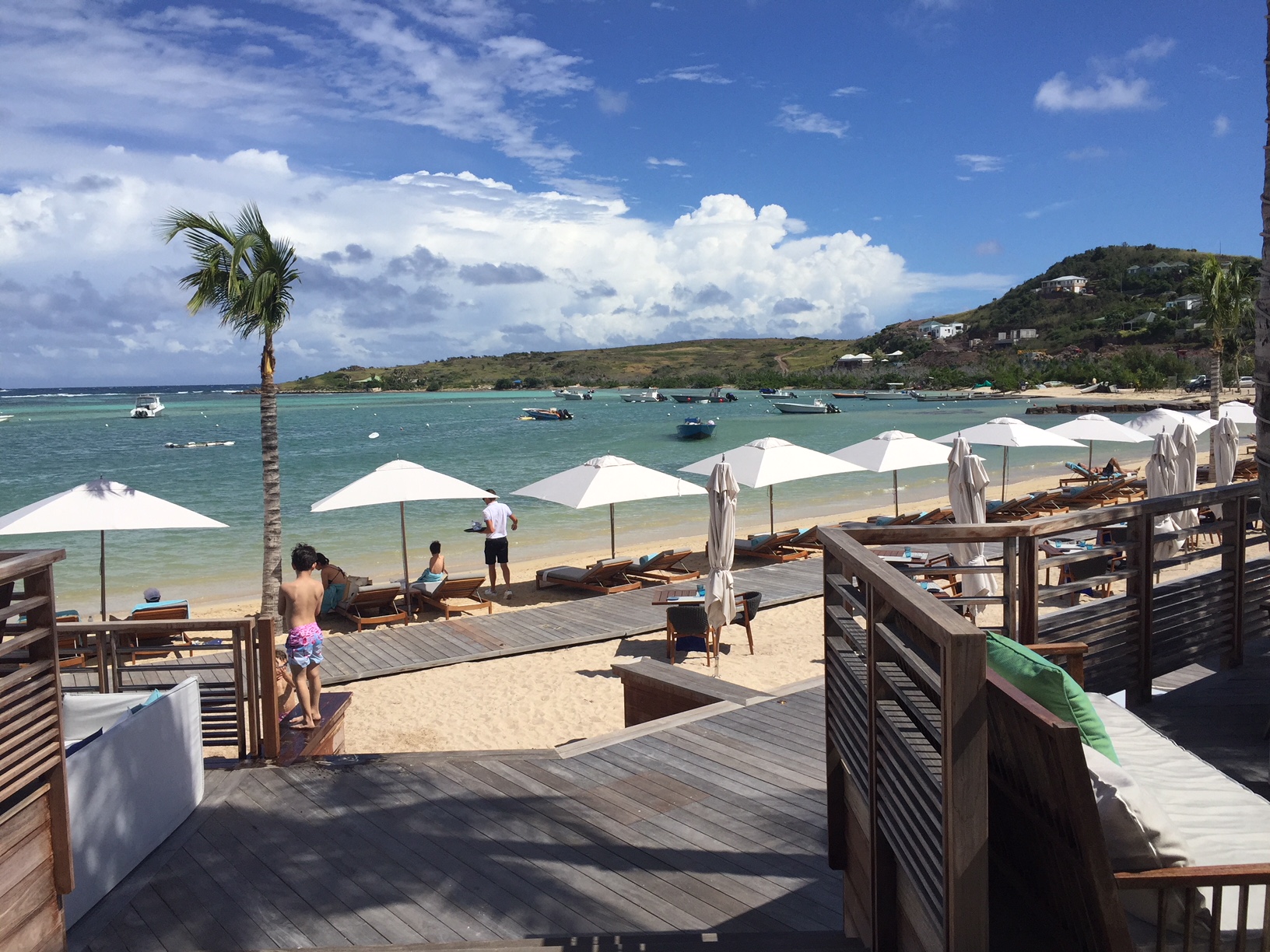 the extra
insurance, and you’ll probably need it.
the extra
insurance, and you’ll probably need it.
As
of this writing, there are four of the deluxe
resorts open—Le Toiny (below), Christopher, Manapany
and Le Barthélemy (right), though this last is
brand new and was due to open this fall anyway.
Only Eden Rock will be closed for the entire
season. Many smaller hotels and villas, out of 800
on the island, have also opened. Many are already
sold out for the season.
Eleven flights a day from St.
Maarten have resumed, though St. Maarten’s main
terminal is still not operational, so passengers
must check in through un-air-conditioned tents.
Meanwhile, on Gustavia’s Rue de la République,
lined with high-end boutiques like Louis Vuitton
and Hermès showing sportswear designed just for
St. Barts, Dolce & Gabbana opened last spring
with a wildly painted surfboard in its window.
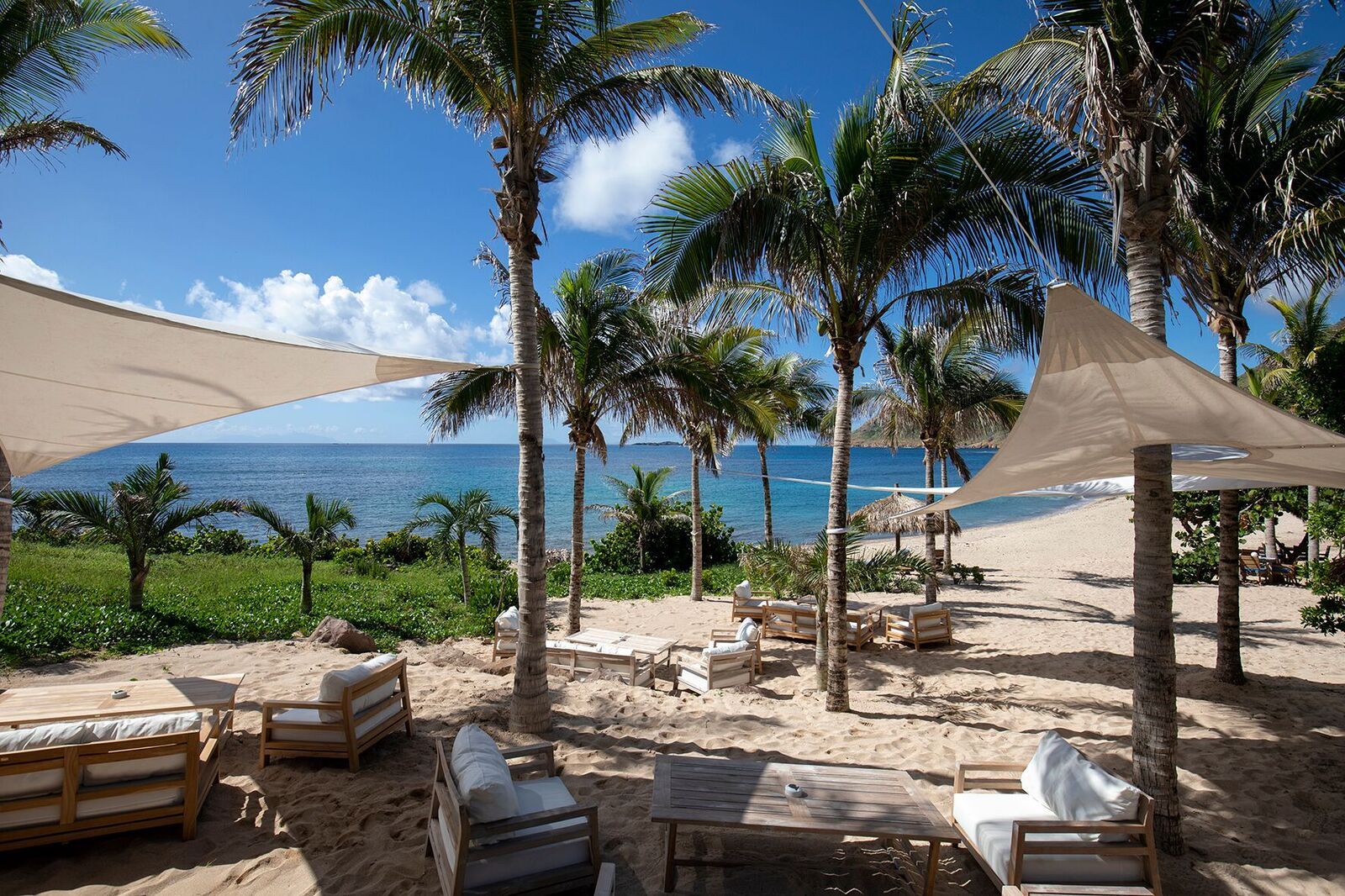 Getting
building materials to St. Barts was difficult but,
according to Anne Jousse, President and CEO of B
Signature Hotels & Resorts, which owns
Manapany, “It’s expensive but available at a
price. The smaller family-owned hotels and villas
had to
get open as soon as possible to recoup losses from
last season.” When I asked if the insurance
companies were slow in responding, she said, “No,
but then we own an insurance company, so it was
not a problem.”
Getting
building materials to St. Barts was difficult but,
according to Anne Jousse, President and CEO of B
Signature Hotels & Resorts, which owns
Manapany, “It’s expensive but available at a
price. The smaller family-owned hotels and villas
had to
get open as soon as possible to recoup losses from
last season.” When I asked if the insurance
companies were slow in responding, she said, “No,
but then we own an insurance company, so it was
not a problem.”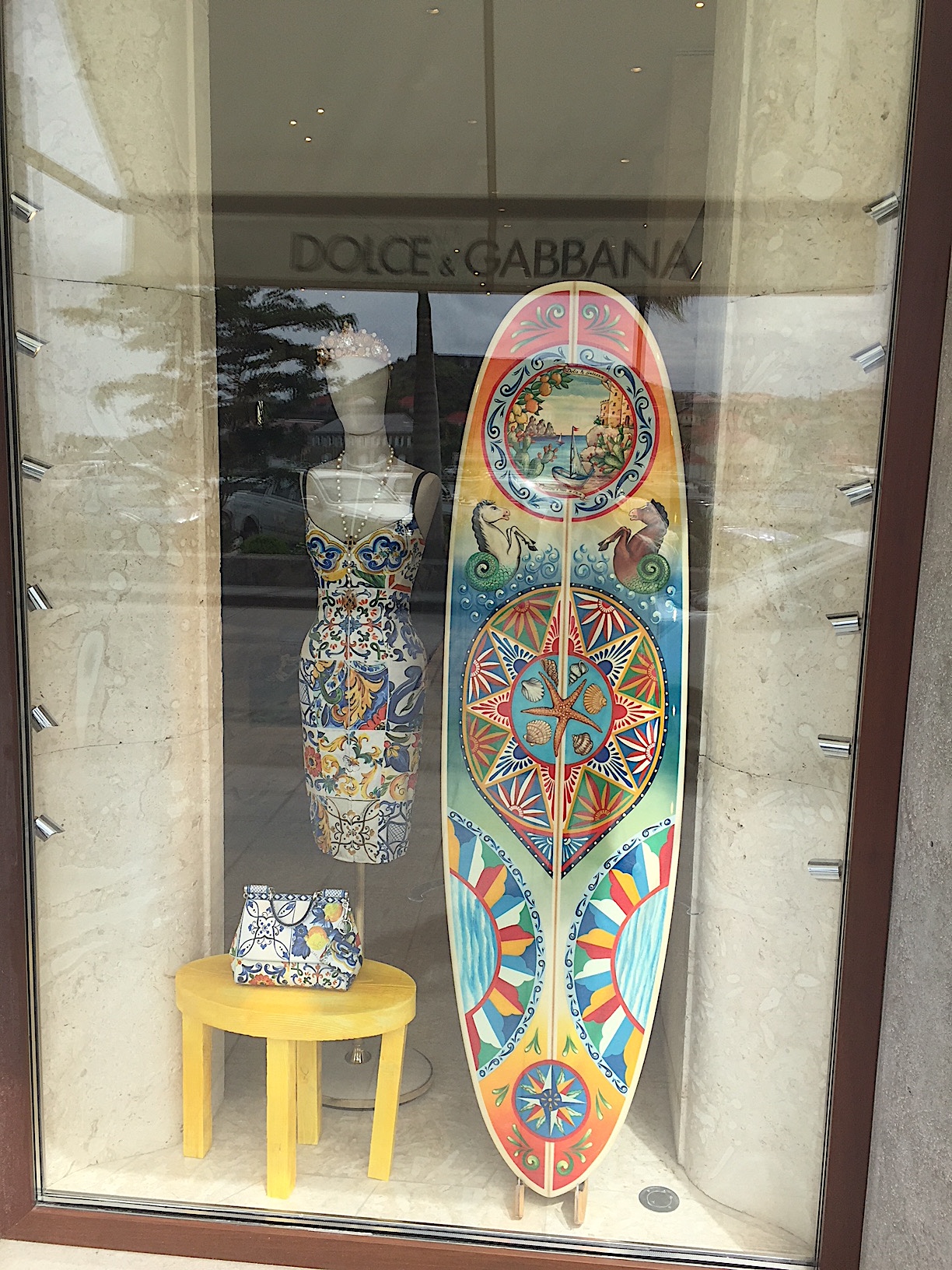
Employing staff is another
problem. There is no unemployment on the island,
but French citizens willing to come to the island
will always find jobs in the resort and
restaurants industry. Owing to the expense of real
estate, however, staff members find it difficult
to afford lodgings.
So resilient are St. Barts’s
residents and entrepreneurs that they were able to
mount a gala Gourmet Festival in the first week of
November this year, after cancelling it last year
owing to the hurricane. (I’ll be reporting on this
event and the dining scene on the island in a
future article.) For the weekend, Air France flew
in six Michelin-starred chefs, plus their
assistants and family members, to work alongside
resort chefs.
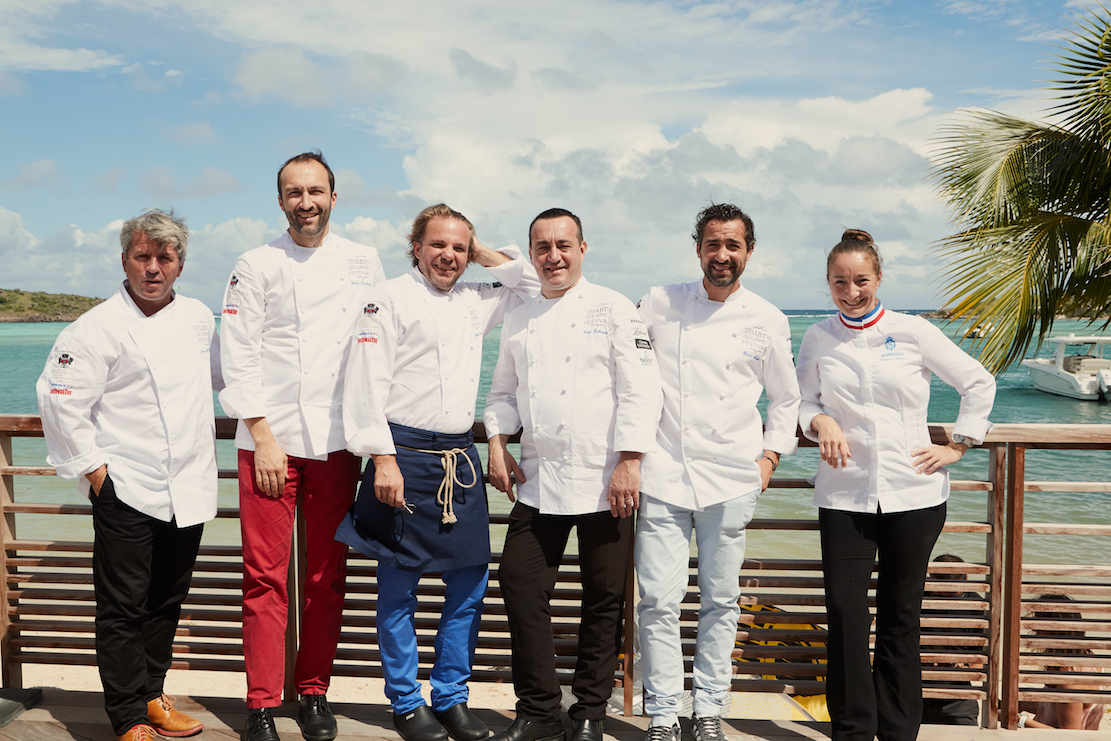 When
I asked Pierre Augé, chef at La Maison de Petit
Pierre in Béziers, how difficult it was to bring
in every ingredient they needed, he shrugged and
said, “When money is no object, it is not so
difficult. We got everything we wanted shipped in
from France.” Local fish were not as easy to come
by.
When
I asked Pierre Augé, chef at La Maison de Petit
Pierre in Béziers, how difficult it was to bring
in every ingredient they needed, he shrugged and
said, “When money is no object, it is not so
difficult. We got everything we wanted shipped in
from France.” Local fish were not as easy to come
by.
Water supply, however, has
always been a problem on the island. There are no
wells, so all water comes from non-potable
rainfall or from a huge desalinization plant using
thermal energy just outside of the capital of
Gustavia.
“Water is very expensive here,”
says Luc Lanza, General Manager of Hotel Le Toiny.
“We take very quick showers and I don’t even wet
my toothbrush before brushing.”
Tellingly, though
St. Barts is a French island, the luxury hotels
did not install bidets.
By John Mariani
222 Lafayette Street (near Spring Street)
646-882-1939
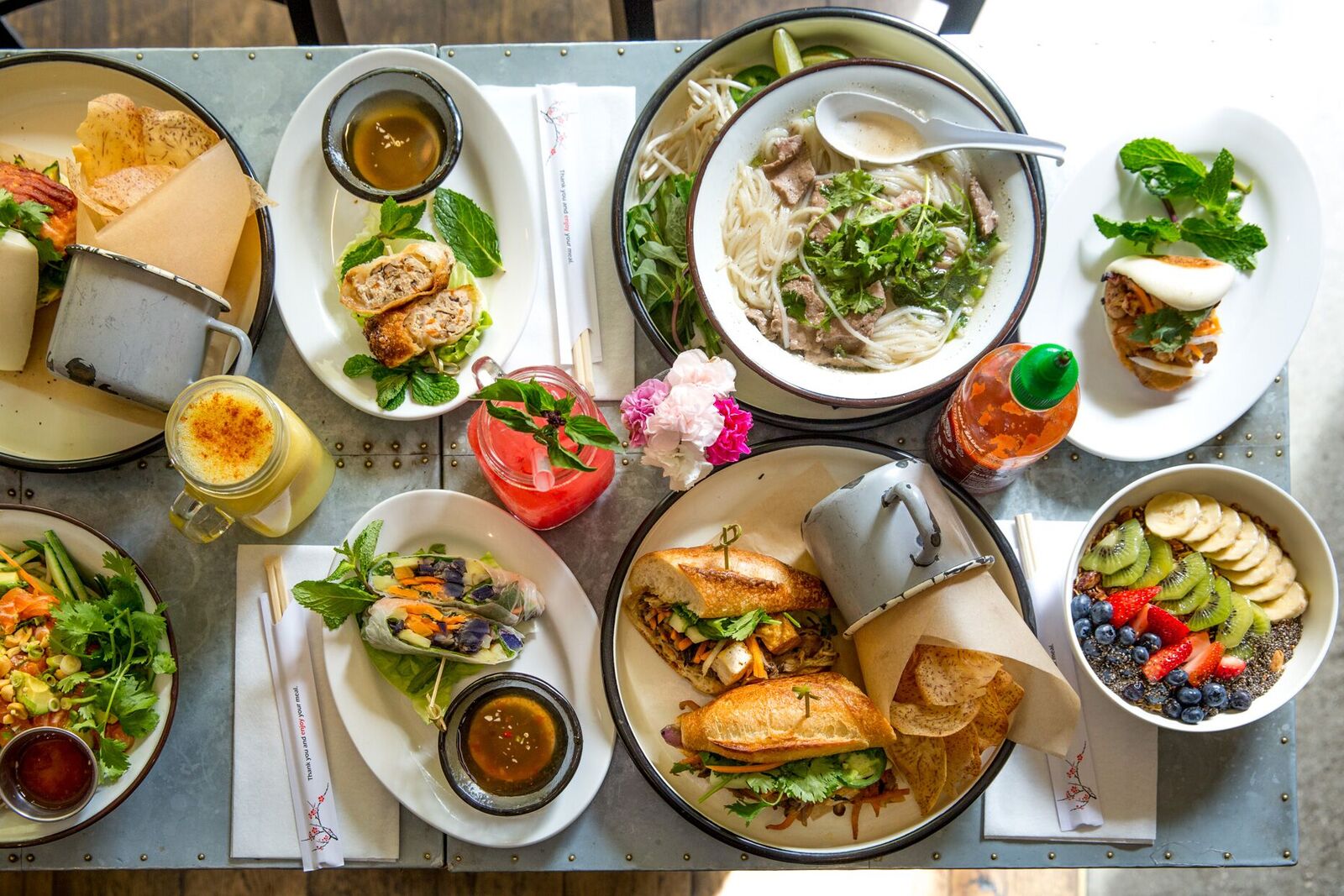
My
avoidance
of restaurants big and small south of
Houston Street is based on way too many
experiences in rooms unconscionably cacophonous,
shrill, clamorous and ear-shattering, owing to
raucously loud patrons and owners who refuse to
baffle the sound but instead add to it with boom
box pounding speakers.
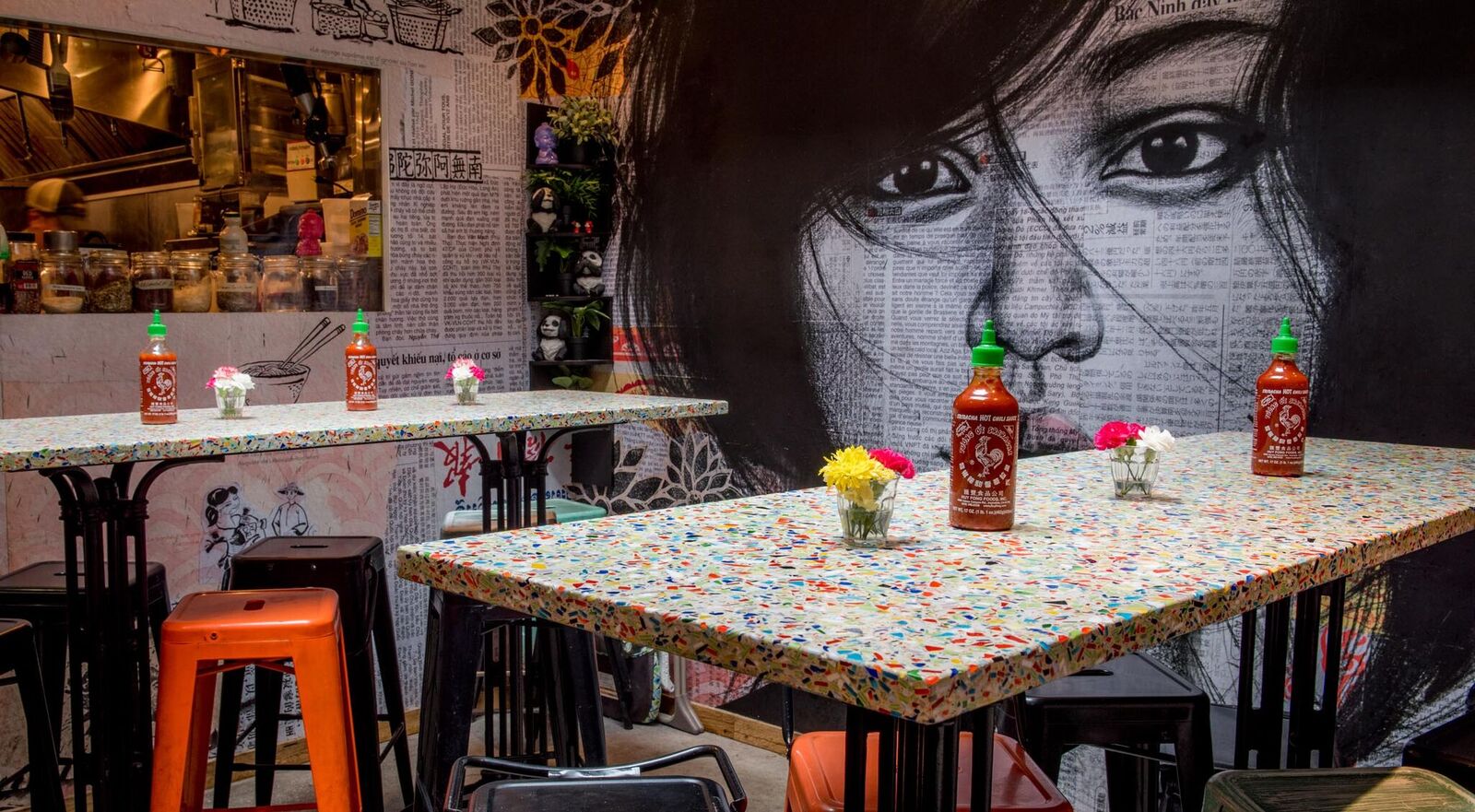 So it was with some
trepidation that I visited Bocaphe in SoHo, which
from the outside looks very much like one of those
decibel-busting eateries. I was so happy to find
that this small, colorful, very cheery Vietnamese
restaurant was not particularly loud at all,
despite a near-full crowd.
So it was with some
trepidation that I visited Bocaphe in SoHo, which
from the outside looks very much like one of those
decibel-busting eateries. I was so happy to find
that this small, colorful, very cheery Vietnamese
restaurant was not particularly loud at all,
despite a near-full crowd.
The look of the place is
enticing, not least the potted plants hanging
upside down from the ceiling, Asian figure
wallpaper, and a striking wall image of a
Vietnamese woman painted over newsprint.
I claim
little knowledge of Vietnamese food, except what
I’ve eaten in America and read about in
authoritative cookbooks like Saigon-born Nicole
Routhier’s The
Foods of Vietnam, in which she describes the
centuries-old influences of Chinese and French
cuisine on Vietnam kitchens. “Vietnamese dishes
are generally light in nature, using little fat,
even in stir-fried foods,” she writes. “Oil- and
starch-laden sauces are virtually unseen. Indeed,
the Vietnamese like their foods as fat-free as
possible, and use vegetable oil instead of lard
for frying.” The use of chili peppers is also
restrained.
Thus, those going to Bocaphe
expecting the fire of Thai or Sichuan cuisine may
be disappointed not to find it. Expect subtlety,
less sweetness.
(There is a bottle of Thai Sriracha sauce
on the table, but, after using a dash on one dish,
I immediately knew it was an error that 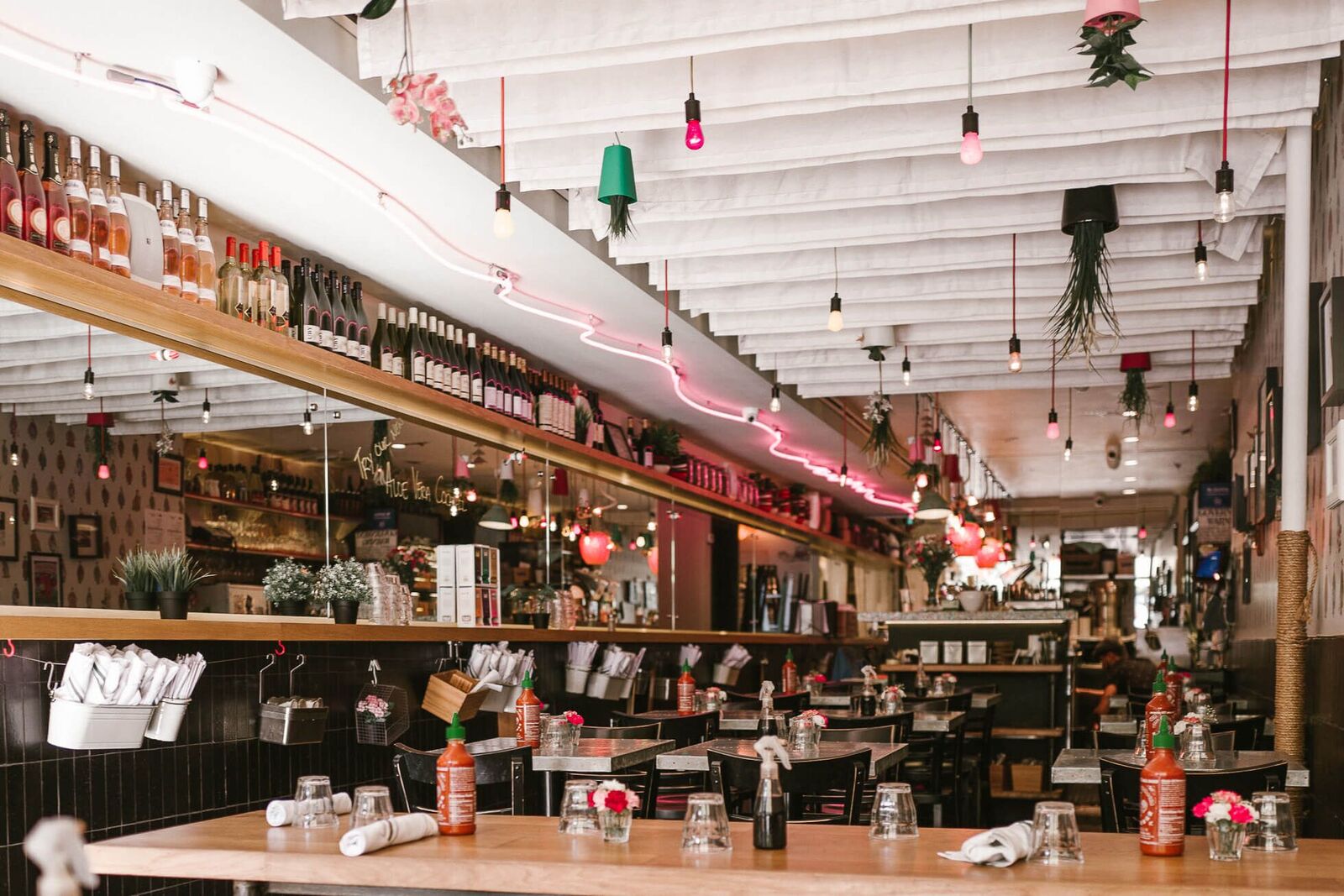 compromised the balance
of flavors.)
compromised the balance
of flavors.)
The categories on the menu are
appetizers, bao
buns, crispy spring rolls, vermicelli noodles, pho
noodle soup, rice bow,
entrees, bao
burger, and salad. We started off with shrimp
tempura ($9), tender and crisp. A bao bun
of eggplant ($5.50) was velvety and served with
pickled vegetables and cilantro on a soft, steamed
bun.
The “classic” pho ($16)
is a big bowl of rich broth, brimming with tender
noodles (you can also have zucchini noodles),
while the chicken and ginger bo bun
of rice noodles, vegetables, lettuce and peanuts
($16) was a meal all in itself. An alternative big
bowl is made with fragrant jasmine rice cooked
tandoori style and seasoned with turmeric that
adds color, served with beef and lemongrass ($17).
Salmon and Thai basil ($19) is also available. The
only disappointment were the taro fries, cut like
French fried potatoes and seasoned, but without
much flavor at all ($7).
The wine
list is small and the dessert list negligible.
Still, Bocaphe may be an education for those not
as familiar with Vietnamese cuisine as with others
from Southeast
Asia. I was quite happy to be educated.
TO RANK WITH THE BEST BURGUNDIES
By John Mariani
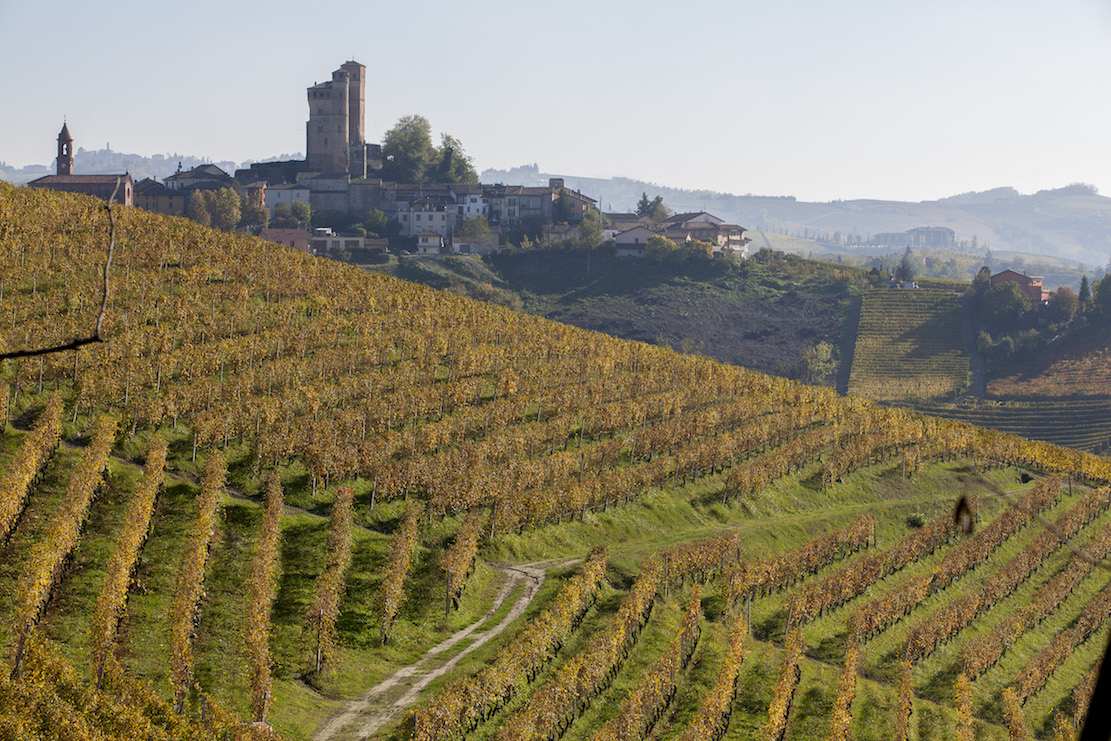
If Paola Lanzavecchia
(below)
has her way, Barolo will soon be a wine ranked
alongside the best names in Burgundy.
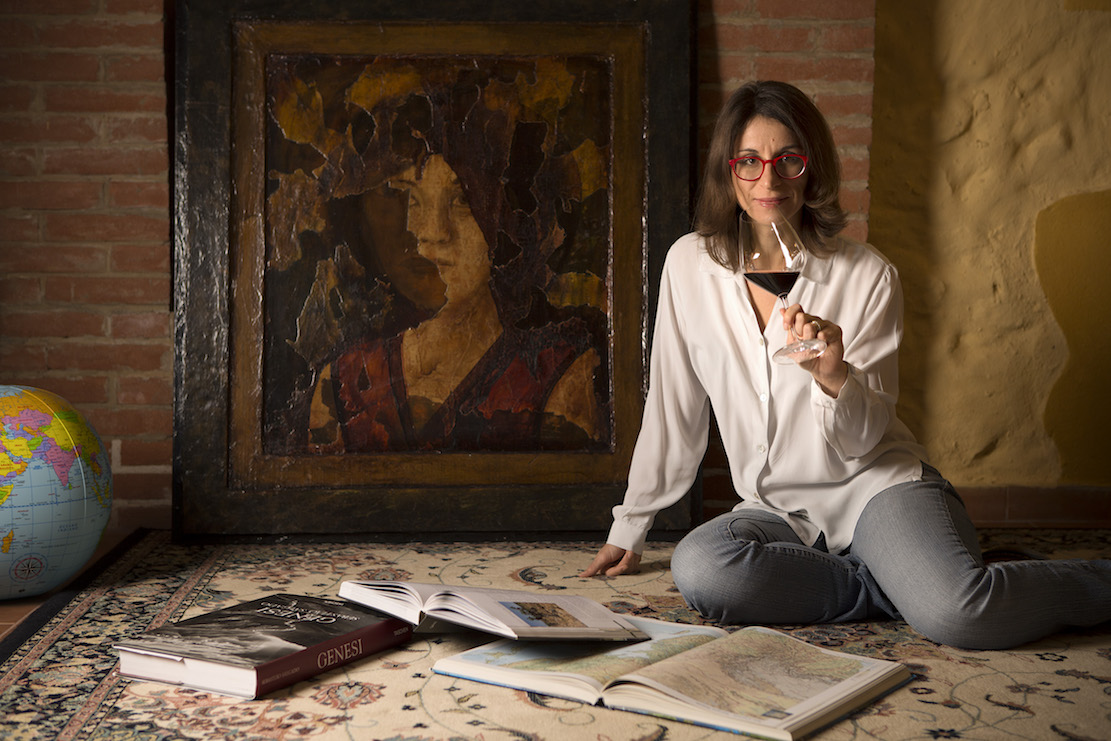 As
winemaker and owner of Villadoria Winery in
Italy’s Piedmont region, she represents the
fourth generation of the Villadoria family, who
have been making wine since 1959, when Pietro
and Pietrina Lanzavecchia planted their first
vines.
As
winemaker and owner of Villadoria Winery in
Italy’s Piedmont region, she represents the
fourth generation of the Villadoria family, who
have been making wine since 1959, when Pietro
and Pietrina Lanzavecchia planted their first
vines.
Back then Barolo and its
sister wine, Barbaresco, were barely known
outside of Piedmont, at a time when Americans
who drank Italian wines knew only Chianti in a
straw-covered bottle and Soave in a green bottle
shaped like a fish. If Barolo were to be found
in a wine store back then, it sold very cheap
and had little reputation.
Barolo gained respect when,
in 1980, it was one of only three wines awarded the
government’s Denominazione
di Origine Controllata Garantita. Barolo
got an enormous boost when the pioneering
Angelo Gaja raised the quality and the prices
for his wines—his “Sperss” label sells for
$300 and up—followed by producers Renato
Ratti, Bruno Giacosa and Giacomo Conterno. So
successful did Barolo become by the 21st
century that there are now more than 500
labels shown on Wine-Searcher.com. And,
according to Lanzavecchia, an acre of vineyard
land in Piedmont can sell for $1.4 million.
Modern producers of
Barolo like Villadoria are aiming more for
finesse than for the traditional powerhouse
style of a century ago,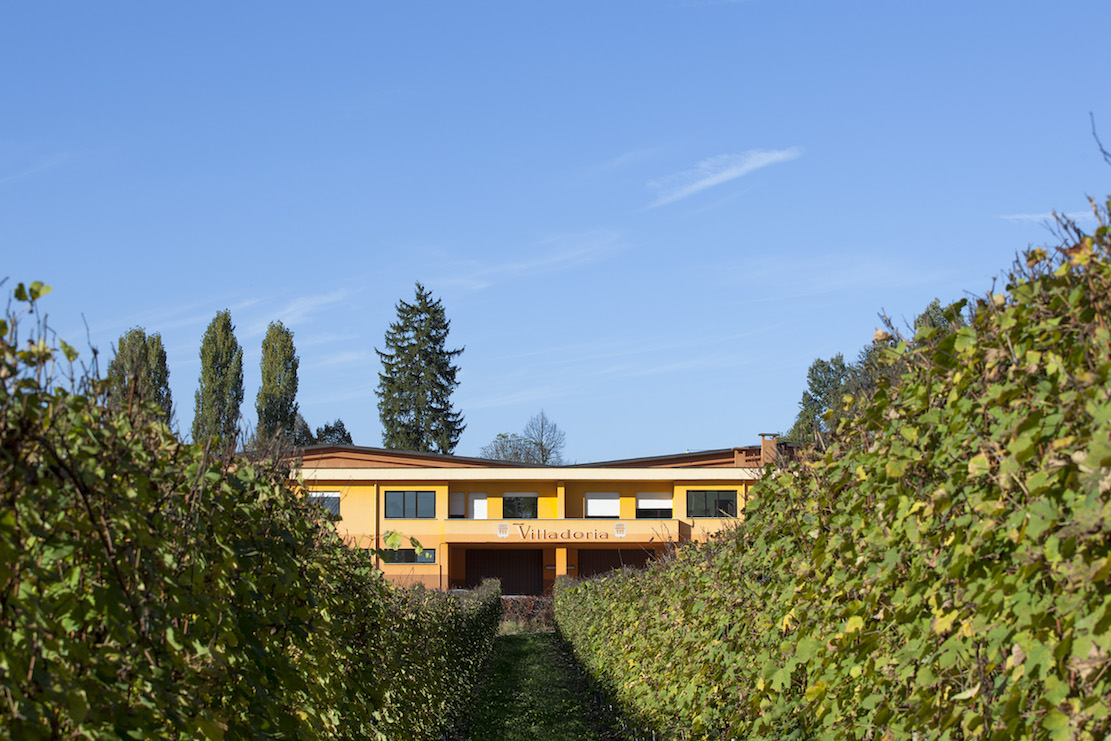 when
grapes might be macerated for 90 days or more to
produce highly tannic wines that took years to
smooth out. These days that maceration style and
aging in large barrels have declined, with
wineries using instead smaller barrels made of
new wood called “barriques.”
when
grapes might be macerated for 90 days or more to
produce highly tannic wines that took years to
smooth out. These days that maceration style and
aging in large barrels have declined, with
wineries using instead smaller barrels made of
new wood called “barriques.”
Villadoria’s Tenuta
Cappallotto vineyards enclose about 50 acres in
the hills of the prestigious terroir of Serralunga d’Alba. The
winery is state-of-the-art, and an historic
farmhouse is still there, with a tasting room
for visitors.
Nebbiolo, the approved varietal for
Barolo and other Piedmont wines, is the most
widely planted, but Villadoria also grows Merlot
and Muscat vines.
Today
the winery is led by Daniele Lanzavecchia, 65,
son of Pietro and Pietrina, and his daughter,
Paola, a graduate in enology from Turin
University, where she specialized in viticulture
and oenology. Today the company has vineyards in
three different MGAs (menzione
geografiche aggiuntive)— Cappallotto,
Lazzarito and Mariame, which produce three
distinctive crus.
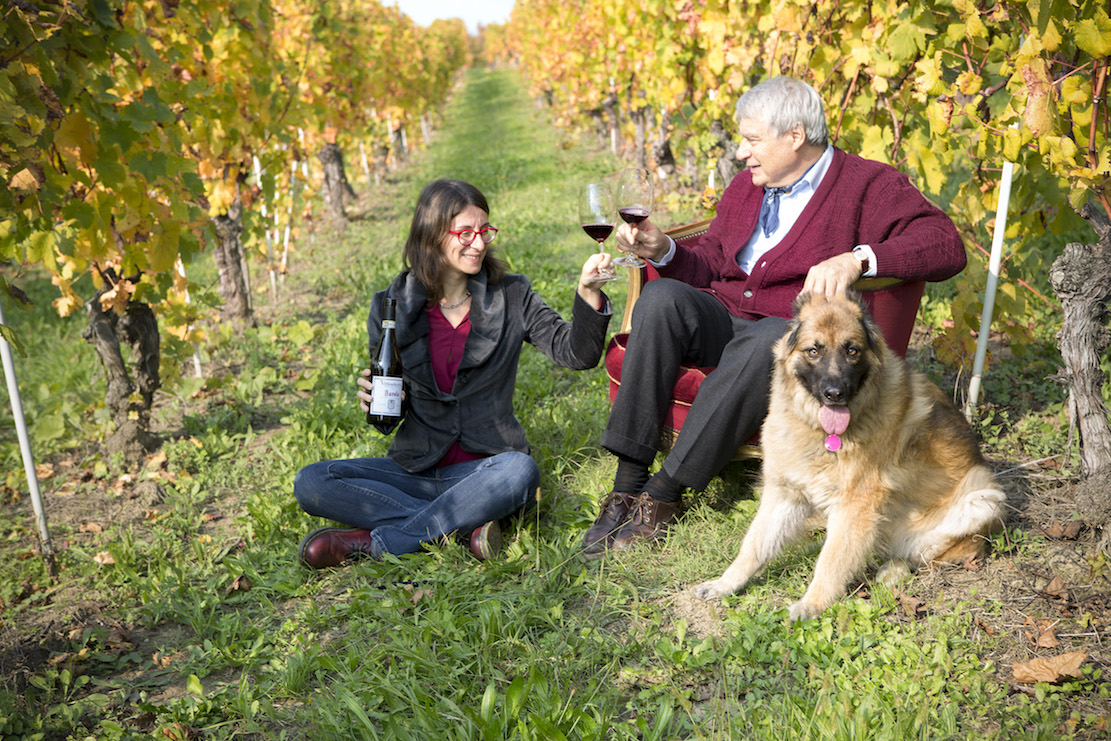 “My
father (below)
was the best teacher,” says Paola, who came
aboard in 2005. “At first I had to go slowly for
three or four years, but we were always
innovating, making refinements every year,
looking for the flavor differences in the
individual terroirs.”
“My
father (below)
was the best teacher,” says Paola, who came
aboard in 2005. “At first I had to go slowly for
three or four years, but we were always
innovating, making refinements every year,
looking for the flavor differences in the
individual terroirs.”
Over dinner in New York, I
tasted three examples from the 2015 vintages.
The Barolo Serralunga ($37) was lush with fruit
and needs only a few years to fully mature. The
Sorí Paradiso ($60) showed more minerality, and
the Lazzarito is not yet available in the
market, so I tasted a barrel sample that was
brawny 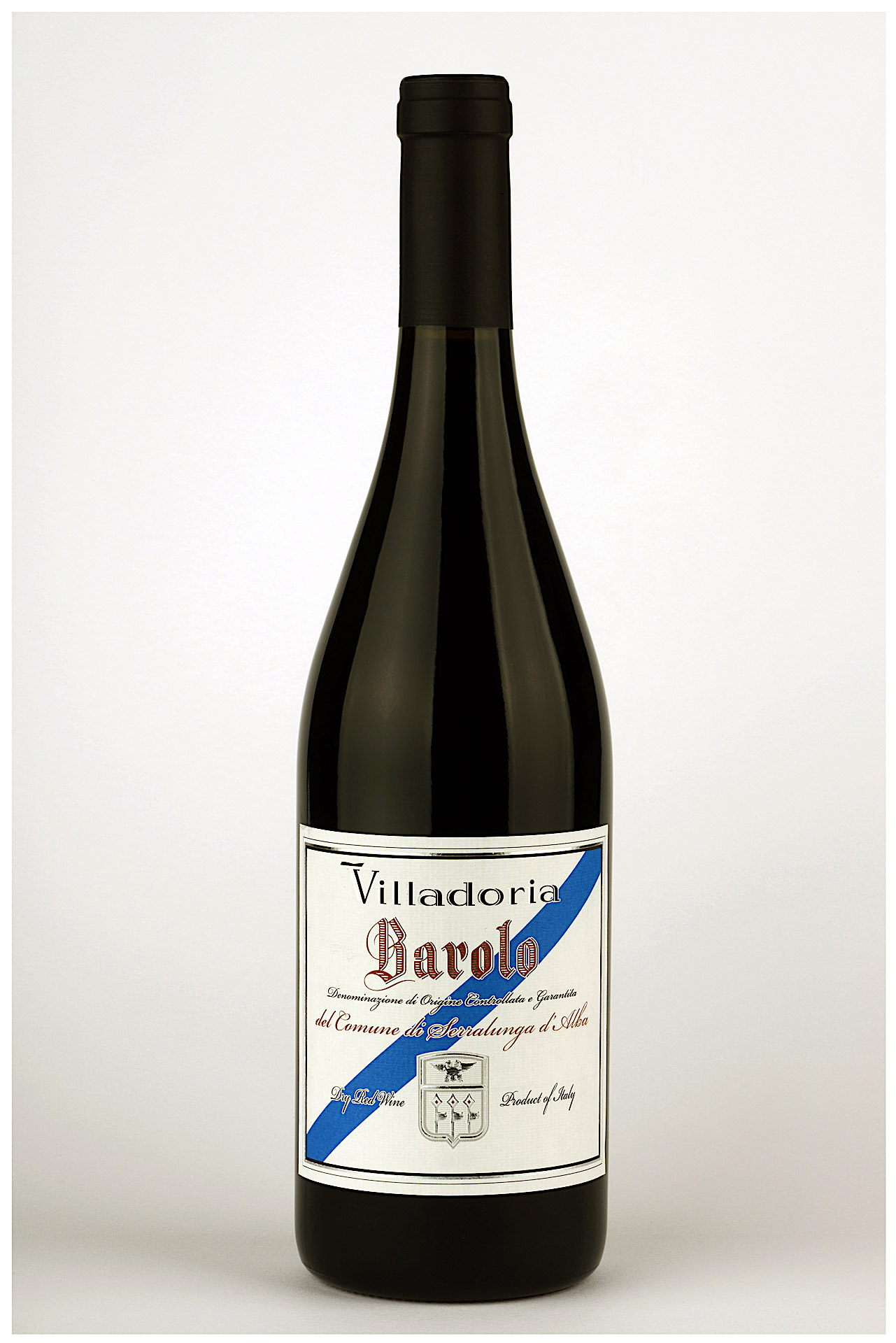 and
tannic. “This is our ‘big boy,’” said Paola,
“made for 20 to 30 years of aging.”
and
tannic. “This is our ‘big boy,’” said Paola,
“made for 20 to 30 years of aging.”
As for all winemakers in
Europe, global warming is a challenge. “It’s not
so much a question of a rise in temperature,”
she said, “although we’ve seen a one-degree rise
in just the last ten years. The more troubling
aspect is that we are seeing more and more
extreme weather we’ve never had before. In 2014
we got hit with a water bomb of rain and had to
select the grapes manually. But 2017 was
completely different, very dry and very hot.”
Ironically,
it’s easier to make big-bodied wines in warmer
weather than more delicate, refined wines. For
the moment, Villadoria is exemplary in
recognizing what needs to be done.
❖❖❖
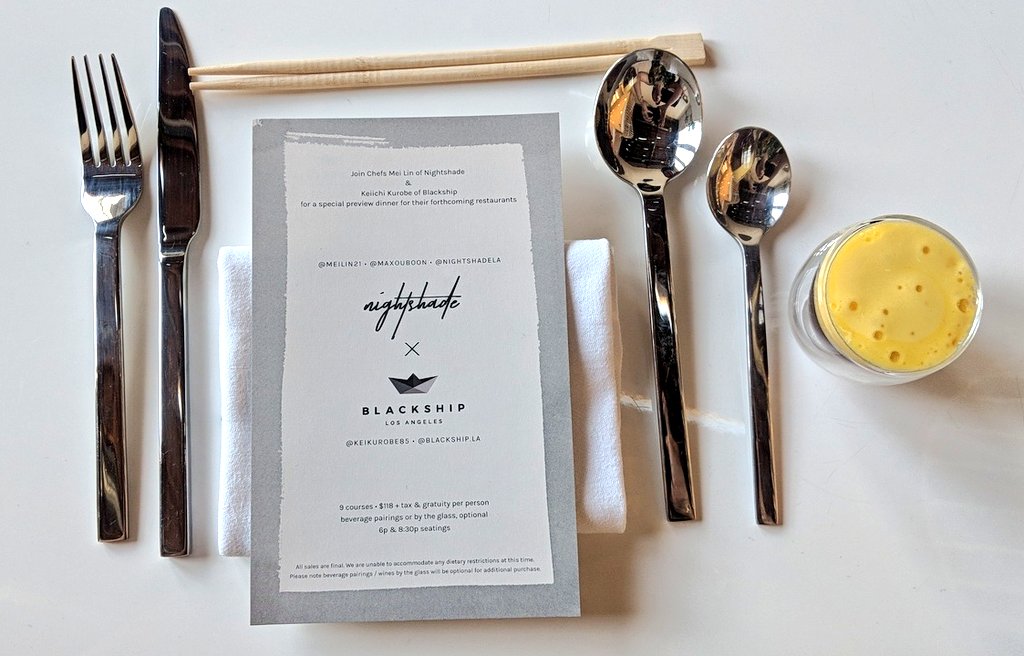 YUM YUM. . .
. . . NOT
YUM YUM. . .
. . . NOTChef
Mei Lin of Nightshade in Los Angeles has
been testing other dishes like a
Nashville-inspired hot chicken served with
Japanese milk bread and octopus that will "deliver
the familiar flavors of General Tso’s chicken,"
adding, “I’m just using everything I’ve
learned and applying it, experimenting — whether
it’s a French, Italian, Asian, or an American
technique. Whatever."
AND MANDARIN EXPRESS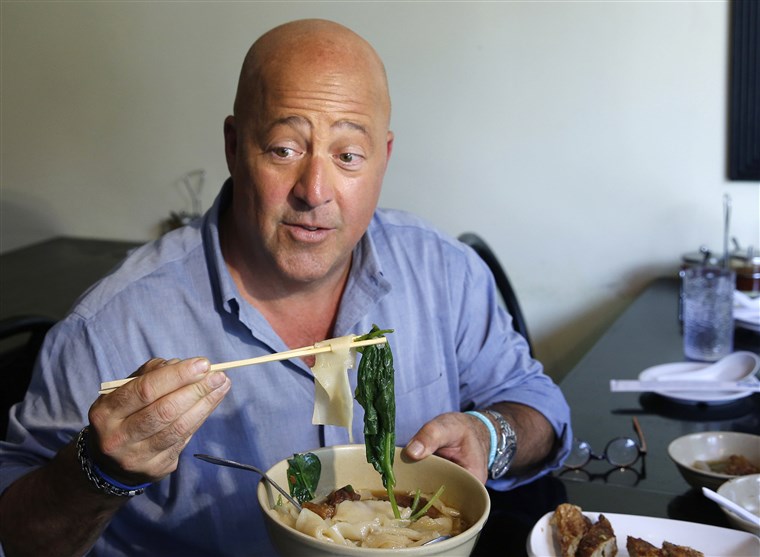
“Over the course of a two-week period I ate at Nobu in
Hawai‘i, Nobu in London, Nobu in New York, and Nobu in
Los Angeles,” said Andrew Zimmern. "They’re exactly the
same. That’s the brilliance of Nobu.”
Wine
Column Sponsored by Banfi Vintners
SANGIOVESE
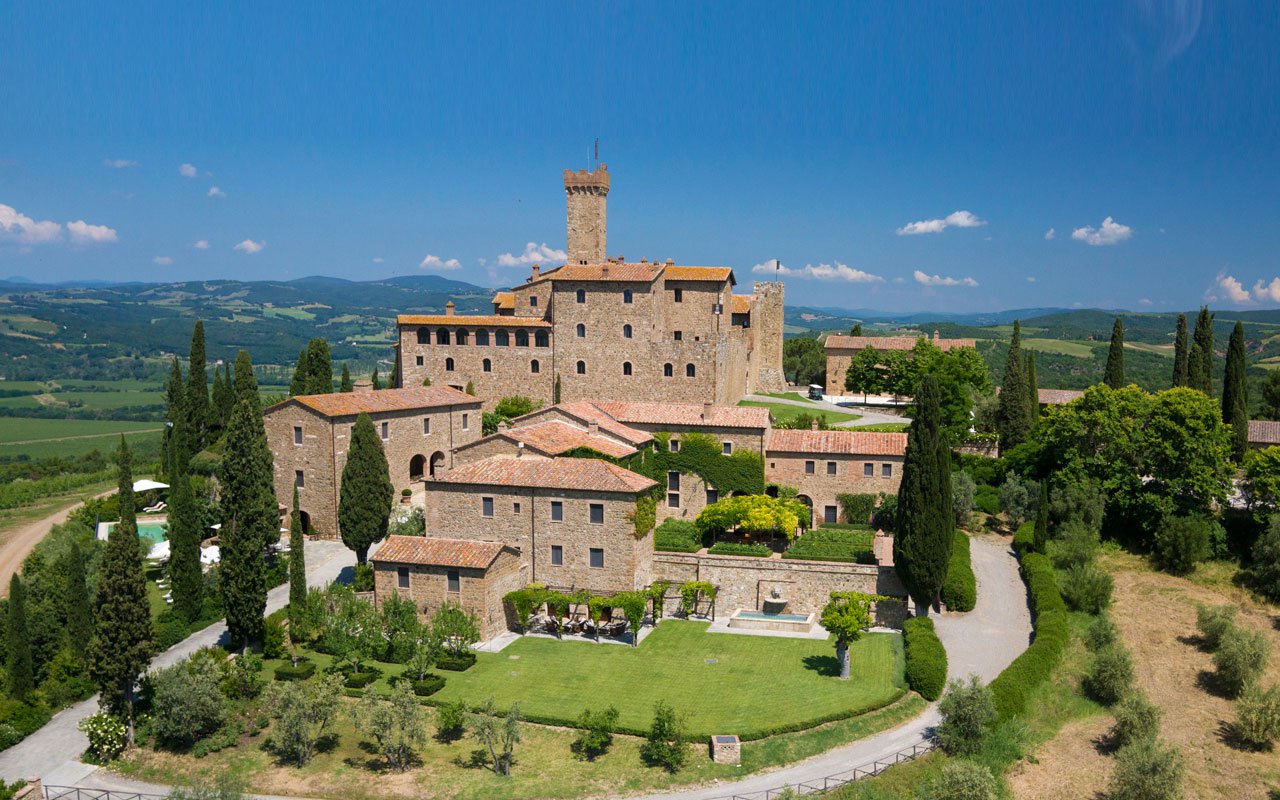 Wine is a joy year-round but
in cooler weather one
grape varietal has really taken center stage in
my daily activities – that most Italian of
grapes, Sangiovese, and its ultimate expression
– Brunello di Montalcino.
Wine is a joy year-round but
in cooler weather one
grape varietal has really taken center stage in
my daily activities – that most Italian of
grapes, Sangiovese, and its ultimate expression
– Brunello di Montalcino.
From mid-September through mid-October,
the Sangiovese grown for our various styles of red
wines are be harvested, culminating with the top
selection for Brunello di Montalcino.
Second, cooler weather here means
it is time to start enjoying more red wines and
especially Sangiovese based wines. That
includes Banfi’s cru of Brunello, Poggio alle Mura,
literally the cream of the crop of our Sangiovese
vineyards. Alongside our Poggio alle Mura Brunello di
Montalcino, this year we introduced two more wines
from the cru Poggio alle Mura – a Rosso di Montalcino
and a Riserva of Brunello. Rosso is sort of like the
younger brother of Brunello, also made from 100%
Sangiovese grapes but usually a selection from younger
vines and the wine is aged only two years compared to
the four required for Brunello. The
Riserva, on the other hand, is an even more selective
harvest of Sangiovese, and ages for an additional year
before release.
What is so special about this cru
Poggio alle Mura?
Well, it is the result our over 30 years of
ongoing research at my family’s vineyard estate,
Castello Banfi.
When we first began planting our vines there in
the late 1970s studies from the University of Bordeaux
indicated which strains of many varietals we should
plant, based on the soil type and microclimate of each
vineyard. But
when it came to the region’s native Sangiovese, there
was only local lore, no scientific research. So we took
it upon ourselves to figure out this vine, and set off
on three decades of incredibly detailed research.
We started
with 600 apparent variations on Sangiovese, because it
is so susceptible to variations in weather and soil,
and narrowed that down to 160 truly genetically
different clones.
We planted a vineyard with two rows of each
type, made wine from each of them, and charted the
differences – remember, you only get one chance a year
to make wine, so this took time.
It took about ten years to get some
concrete results, though we continue to experiment
today and always will – you never stop learning in
science and nature!
Once we determined which were the best,
complementary clones that could be planted together to
make the best Brunello, we chose to plant them in what
we determined to be the optimal vineyard sites. Coincidentally,
the best soils and climate conditions are in the
slopes surrounding the medieval fortress today known
as Castello Banfi, known since Etruscan times as
Poggio alle Mura – the walled hilltop. Hence the
name of our most special “cru” of Brunello,
representing a synthesis between tradition and
innovation.
Though the focus of this study was
our Brunello, all of our Sangiovese-based wines,
including the super Tuscans SummuS, Cum Laude, and
Centine, benefitted from this work. And that’s
the third reason for celebrating Sangiovese this
month, for the range of wonderful reds that usher us
into autumn! One
wine in particular was inspired by our research – the
BelnerO, a Sangiovese dominant blend with what I like
to call a kiss of Cabernet and a whisper of Merlot. We grow the
grapes a little differently for BelnerO than for
Brunello, make the wine with less oak aging and
released it earlier from the winery, providing a
counterpoint to Brunello and a lovely terroir-driven
wine in its own right.
If you
know Italians, you know that by nature we are
multi-faceted, varying in mood, and always passionate. As a
nation, we span from the hot sunny beaches of Sicily
near the African coast to the rugged mountains and
Alpine ski slopes of Trentino-Alto Adige in the north. Sangiovese
is grown in almost all of Italy’s regions and reflects
the unique nature of each; it is most famous
(rightfully so) in Tuscany, yet even there it reflects
the nuances of each hilltop, valley and subzone. It has
something a little different to say in Brunello than
Chianti, Morellino than Vino Nobile di Montepulciano,
Rosso di Montalcino than Super Tuscan blends.
Here is a smattering of
Sangiovese-based wines that you may wish to get to
know better, reflecting a spectrum that appeals to
every occasion, every taste, and every budget. We can
assure you that the conversation will never become
boring. 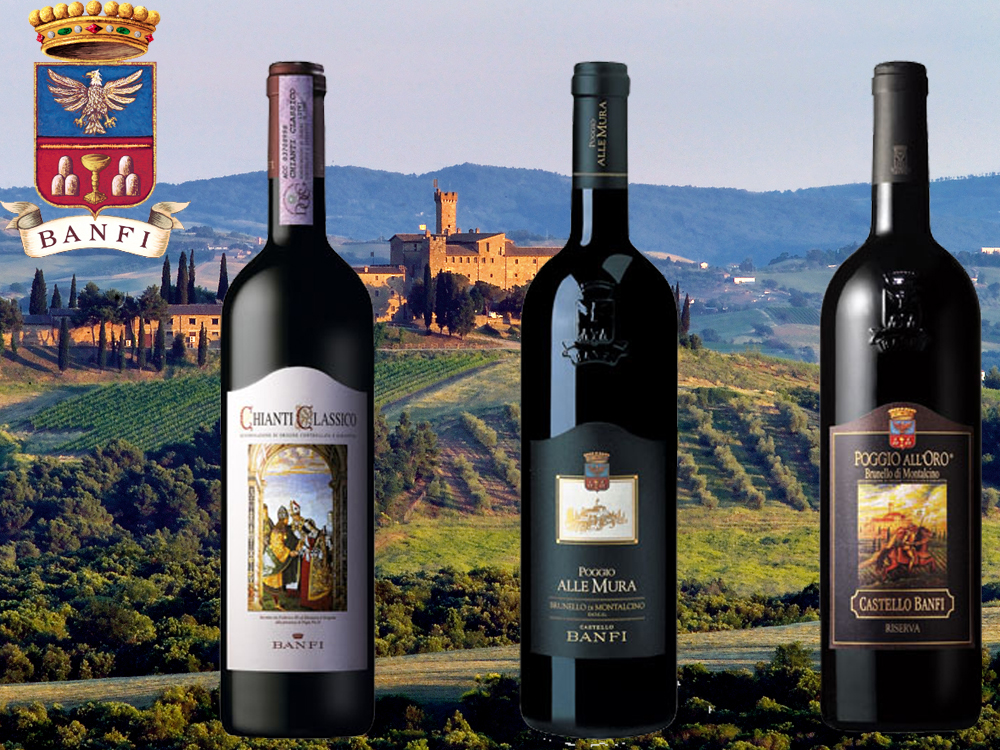
Recommendations for Celebrating
Sangiovese
BelnerO Proprietor’s Reserve Sangiovese
– A refined
cuvée of noble red grapes perfected by our pioneering
clonal research. This dark beauty, BelnerO, is
produced at our innovative winery, chosen 11
consecutive years as Italy’s Premier Vineyard Estate.
Fermented in our patented temperature controlled
French oak and aged approximately 2 additional years.
Unfiltered, and Nitrogen bottled to minimize sulfites.
Castello Banfi Brunello di Montalcino –
Rich, round, velvety and intensely
aromatic, with flavor hints of licorice, cherry, and
spices. Brunello di Montalcino possesses an intense
ruby-red color, and a depth, complexity and opulence
that is softened by an elegant, lingering aftertaste.
Unfiltered after 1998 vintage.
Castello Banfi Rosso di Montalcino – Brunello's "younger brother," produced
from select Sangiovese grapes and aged in barrique for
10 to 12 months. Deep ruby-red, elegant, vibrant,
well-balanced and stylish with a dry velvety
finish.
Poggio all’Oro Brunello di Montalcino
Riserva – A single vineyard selection of our most
historically outstanding Sangiovese, aged five years
before release, the additional year more than that
required of Brunello including 6 months in barrel and
6 months more in bottle to grant its “Riserva”
designation. Incredible
elegance and harmony. Intense with lots of fruit and
subtle wood influence. Round, complete, well balanced
with hints of chocolate and berries. Unfiltered after
1998.
Poggio alle Mura – The first tangible result of years of
intensive clonal research on Montalcino’s native
Sangiovese grape.
Estate bottled from the splendidly sun drenched
vineyards surrounding the medieval Castello from which
it takes its name.
The Brunello
di Montalcino is seductive, silky and smoky. Deep ruby
in color with an expressive bouquet of violets, fruits
and berries as well as cigar box, cedar and exotic
spices. The Rosso
di Montalcino is also intense ruby red. The bouquet
is fresh and fruity with typical varietal notes of
cherry and blackberry, enriched by more complex hints
of licorice, tobacco and hazelnut. It is full
bodied, yet with a soft structure, and a surprisingly
long finish. The Poggio alle Mura Brunello di Montalcino
Riserva is deep ruby red with garnet
reflections and a rich, ample bouquet that hints of
prune jam, coffee, cacao and a light balsamic note. It is full
and powerful, with ripe and gentle tannins that make
it velvety and harmonious; this wine is supported by a
pleasing minerality that to me speaks soundly of that
special hillside in southern Montalcino.
SummuS – A wine of towering elegance, SummuS is an
extraordinary blend of Sangiovese which contributes
body; Cabernet Sauvignon for fruit and structure; and
Syrah for elegance, character and a fruity bouquet. An elegant,
complex and harmonious red wine.
Cum Laude – A complex and elegant red which graduated
“With Honors,” characterized by aromas of juicy
berries and fresh spices.
Centine – A Cuvee that is more than half
Sangiovese, the balanced consisting of equal parts of
Cabernet Sauvignon and Merlot. Vinified in
a firm, round style that easily accompanies a wide
range of dishes, this is a smooth and fragrantly
satisfying wine with international character, and a
perennial favorite at my own dinner table.
Banfi Chianti Superiore – The “Superiore” designation signifies
stricter government regulations regarding production
and aging requirements, as compared to regular
Chianti. An
intense ruby red wine with fruit forward aromas and
floral notes. This
is a round wine with well-balanced acidity and fruit.
Banfi Chianti Classico – An enduring classic: alluring
bouquet of black fruit and violets; rich flavors of
cherry and leather; supple tannins and good acidity
for dining.
Banfi Chianti Classico Riserva – Produced from select grapes grown in the
"Classico" region of Chianti, this dry, fruity and
well-balanced red has a full bouquet reminiscent of
violets.
Fonte alla Selva Chianti Classico – This is our newest entry into the Chianti
arena, coming from a 99 acre estate in Castellina, the
heart of the Chianti Classico region. The wine is
a captivating mauve red that smells of cherry, plum
and blackberry with hints of spice. It is
round, full and balanced with very good
acidity.
Col di Sasso – Sangiovese and Cabernet Sauvignon. Luscious,
complex and soft with persistent notes of fruit and
great Italian style structure.
Any of John Mariani's books below may be ordered from amazon.com.
 The Hound in Heaven
(21st Century Lion Books) is a novella, and
for anyone who loves dogs, Christmas, romance,
inspiration, even the supernatural, I hope you'll find
this to be a treasured favorite. The story
concerns how, after a New England teacher, his wife and
their two daughters adopt a stray puppy found in their
barn in northern Maine, their lives seem full of promise.
But when tragedy strikes, their wonderful dog Lazarus and
the spirit of Christmas are the only things that may bring
his master back from the edge of despair.
The Hound in Heaven
(21st Century Lion Books) is a novella, and
for anyone who loves dogs, Christmas, romance,
inspiration, even the supernatural, I hope you'll find
this to be a treasured favorite. The story
concerns how, after a New England teacher, his wife and
their two daughters adopt a stray puppy found in their
barn in northern Maine, their lives seem full of promise.
But when tragedy strikes, their wonderful dog Lazarus and
the spirit of Christmas are the only things that may bring
his master back from the edge of despair. WATCH THE VIDEO!
“What a huge surprise turn this story took! I was completely stunned! I truly enjoyed this book and its message.” – Actress Ali MacGraw
“He had me at Page One. The amount of heart, human insight, soul searching, and deft literary strength that John Mariani pours into this airtight novella is vertigo-inducing. Perhaps ‘wow’ would be the best comment.” – James Dalessandro, author of Bohemian Heart and 1906.
“John Mariani’s Hound in Heaven starts with a well-painted portrayal of an American family, along with the requisite dog. A surprise event flips the action of the novel and captures us for a voyage leading to a hopeful and heart-warming message. A page turning, one sitting read, it’s the perfect antidote for the winter and promotion of holiday celebration.” – Ann Pearlman, author of The Christmas Cookie Club and A Gift for my Sister.
“John Mariani’s concise, achingly beautiful novella pulls a literary rabbit out of a hat – a mash-up of the cosmic and the intimate, the tragic and the heart-warming – a Christmas tale for all ages, and all faiths. Read it to your children, read it to yourself… but read it. Early and often. Highly recommended.” – Jay Bonansinga, New York Times bestselling author of Pinkerton’s War, The Sinking of The Eastland, and The Walking Dead: The Road To Woodbury.
“Amazing things happen when you open your heart to an animal. The Hound in Heaven delivers a powerful story of healing that is forged in the spiritual relationship between a man and his best friend. The book brings a message of hope that can enrich our images of family, love, and loss.” – Dr. Barbara Royal, author of The Royal Treatment.
 |
The Encyclopedia of American Food and Drink by John F. Mariani (Bloomsbury USA, $35) Modesty forbids me to praise my own new book, but let me proudly say that it is an extensive revision of the 4th edition that appeared more than a decade ago, before locavores, molecular cuisine, modernist cuisine, the Food Network and so much more, now included. Word origins have been completely updated, as have per capita consumption and production stats. Most important, for the first time since publication in the 1980s, the book includes more than 100 biographies of Americans who have changed the way we cook, eat and drink -- from Fannie Farmer and Julia Child to Robert Mondavi and Thomas Keller. "This book is amazing! It has entries for everything from `abalone' to `zwieback,' plus more than 500 recipes for classic American dishes and drinks."--Devra First, The Boston Globe. "Much needed in any kitchen library."--Bon Appetit. |
"Eating Italian will never be the same after reading John Mariani's entertaining and savory gastronomical history of the cuisine of Italy and how it won over appetites worldwide. . . . This book is such a tasteful narrative that it will literally make you hungry for Italian food and arouse your appetite for gastronomical history."--Don Oldenburg, USA Today. "Italian
restaurants--some good, some glitzy--far
outnumber their French rivals. Many of
these establishments are zestfully described
in How Italian Food Conquered the World, an
entertaining and fact-filled chronicle by
food-and-wine correspondent John F.
Mariani."--Aram Bakshian Jr., Wall Street
Journal.
"Equal parts
history, sociology, gastronomy, and just
plain fun, How Italian Food Conquered the
World tells the captivating and delicious
story of the (let's face it) everybody's
favorite cuisine with clarity, verve and
more than one surprise."--Colman Andrews,
editorial director of The Daily
Meal.com. "A fantastic and fascinating
read, covering everything from the influence
of Venice's spice trade to the impact of
Italian immigrants in America and the
evolution of alta cucina. This book will
serve as a terrific resource to anyone
interested in the real story of Italian
food."--Mary Ann Esposito, host of PBS-TV's
Ciao
Italia. "John Mariani has written the
definitive history of how Italians won their
way into our hearts, minds, and
stomachs. It's a story of pleasure over
pomp and taste over technique."--Danny Meyer,
owner of NYC restaurants Union Square
Cafe, The Modern, and Maialino.
|
 |
 |
 |
 |
 |
 |
 |
 |
 Everett Potter's Travel Report:
Everett Potter's Travel Report: 
 Eating Las Vegas
JOHN CURTAS has been covering the Las Vegas
food and restaurant scene since 1995. He is
the co-author of EATING LAS VEGAS – The 50
Essential Restaurants (as well as
the author of the Eating Las Vegas web site: www.eatinglasvegas.
He can also be seen every Friday morning as
the “resident foodie” for Wake Up With the
Wagners on KSNV TV (NBC) Channel 3 in
Las Vegas.
Eating Las Vegas
JOHN CURTAS has been covering the Las Vegas
food and restaurant scene since 1995. He is
the co-author of EATING LAS VEGAS – The 50
Essential Restaurants (as well as
the author of the Eating Las Vegas web site: www.eatinglasvegas.
He can also be seen every Friday morning as
the “resident foodie” for Wake Up With the
Wagners on KSNV TV (NBC) Channel 3 in
Las Vegas.
MARIANI'S VIRTUAL GOURMET
NEWSLETTER is published weekly. Publisher: John Mariani. Editor: Walter Bagley. Contributing Writers: Christopher Mariani,
Robert Mariani, Misha Mariani, John A. Curtas, Gerry Dawes, Geoff Kalish,
and Brian Freedman. Contributing
Photographer: Galina Dargery. Technical
Advisor: Gerry
McLoughlin.
If you wish to subscribe to this
newsletter, please click here: http://www.johnmariani.com/subscribe/index.html
© copyright John Mariani 2017

